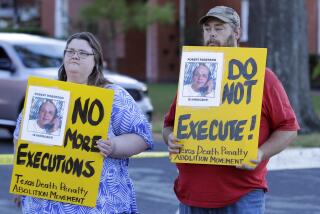Florida suspends executions after trouble injecting inmate
MIAMI — Florida Gov. Jeb Bush on Friday suspended executions until at least March while investigators examine why it took more than half an hour for a lethal injection to kill a convicted murderer.
Angel Nieves Diaz, 55, appeared to grimace in pain and struggle for breath during the Wednesday night execution until a second dose of the fatal drugs was administered, according to witnesses.
The execution at Florida State Prison in Starke took 34 minutes, three times longer than usual. That probably was because the injection was made into soft tissue on the prisoner’s arm, missing a vein that would have carried the killing agents more swiftly to his vital organs.
Death penalty critics said the execution, which they described as “botched,” was clear evidence that the lethal-injection process constituted cruel and unusual punishment.
Diaz, a Puerto Rican convicted of killing the manager of a topless bar in 1979, had challenged the constitutionality of lethal injection in his last legal appeal, which was not taken up by the U.S. Supreme Court.
In his eight years as governor, Bush has signed 39 death warrants; 21 executions have been conducted on his watch. He has denied all death-row appeals for clemency or a commuted sentence to life imprisonment.
Gov. Anibal Acevedo Vila of Puerto Rico, which abolished capital punishment in 1929, had appealed to Bush to convert Diaz’s sentence.
Bush said he would not sign death warrants or allow executions until a probe of the Diaz case is complete. He asked for a report from investigators by March 1.
Bush leaves office in two weeks, but his successor, Charlie Crist, campaigned on promises of continuity with the popular, two-term governor’s policies and values.
Suspension of one of the country’s most active execution chambers was announced after preliminary autopsy results showed the first chemical injection had missed the vein.
In a conference call with journalists, Medical Examiner William Hamilton declined to say whether Diaz suffered intense pain as a result of the misapplied first dose. He confirmed, however, that the convict’s body had a 12-inch chemical burn on the right arm and an 11-inch burn on the left arm.
The first drug of the series is an anesthetic and the second induces paralysis. The third causes cardiac arrest. Media representatives who witnessed the execution gave detailed accounts of the prisoner writhing, grimacing and struggling for breath for 20 minutes.
Mark Elliott of Floridians for Alternatives to the Death Penalty said said the Diaz case showed the need for a moratorium on executions and a thorough review of the state’s criminal justice system, which he said was “broken from top to bottom.”
Florida has 375 inmates on death row. Three juveniles were removed last year after the Supreme Court ruled that execution of minors was unconstitutional.
Florida has executed 64 convicts since the death penalty was reinstated in 1979, initially by electric chair.
The state switched from electrocution to lethal injection in 2000 after two incidents in the ‘90s in which flames burst from prisoners’ heads in a chair dubbed by executioners as “Old Sparky.”
More to Read
Sign up for Essential California
The most important California stories and recommendations in your inbox every morning.
You may occasionally receive promotional content from the Los Angeles Times.











